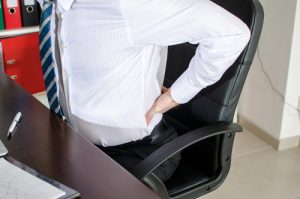 Eighty percent of people report having low back pain in their lifetime, and the phenomenon has been worsening. According to the National Institute of Health, in the 1990s, it was the sixth most “burdensome condition” affecting Americans. By 2010, it had jumped to the third highest.
Eighty percent of people report having low back pain in their lifetime, and the phenomenon has been worsening. According to the National Institute of Health, in the 1990s, it was the sixth most “burdensome condition” affecting Americans. By 2010, it had jumped to the third highest.
Lower back pain seems hard to treat because it can come from a variety of factors. The back is the nexus of a complex system with interconnected muscles, tendons, fascia, discs, and bones. Lower back pain can come from your posture, from walking improperly, poor pelvic alignment, glutes, abs, or lats not working, no movement in your lumbar spine, and muscle imbalance from repetitive motion — to name a few causes. The good news is, whatever the case, it can most often be fixed.
 The positions you put your body in will dictate your posture, which in turn dictates your ability to function. Slouching is a perfect example: When you slouch, you are not using your muscles to hold your body up. Instead, you are instead hanging on your fascia and musculotendinous junctions (where the muscles and tendons meet). You round your upper back, which causes your shoulder blades to elevate and rotate out of position. When you stand, your scapula gets stuck in this position because the muscles are too stretched out to contract properly, while they should be supporting you. Then your lat muscle becomes inefficient and you rely on the low-back fascia-musculotendinous junction to hold you up. Lower-back pain will follow.
The positions you put your body in will dictate your posture, which in turn dictates your ability to function. Slouching is a perfect example: When you slouch, you are not using your muscles to hold your body up. Instead, you are instead hanging on your fascia and musculotendinous junctions (where the muscles and tendons meet). You round your upper back, which causes your shoulder blades to elevate and rotate out of position. When you stand, your scapula gets stuck in this position because the muscles are too stretched out to contract properly, while they should be supporting you. Then your lat muscle becomes inefficient and you rely on the low-back fascia-musculotendinous junction to hold you up. Lower-back pain will follow.
You can see the cascading effect that one postural deficit will have on your lower back, but similar chain reactions occur from walking incorrectly, if your pelvis is out of alignment, or if your head is too far forward.
We’ve shown you how to fix a slouch, so let’s focus on the next huge cause of lower-back pain, your pelvis. Over 33 sets of muscles connect to the pelvis, and the body is built upward and downward from there. We need to create proper alignment here first to create balance elsewhere in the body. Ideally, at rest, your pelvis should be in pelvic neutral. As you move, the pelvis should alternate between posterior and anterior rotation. However, clinically I see the pelvis get stuck in an anterior rotation (tilted forward). Once that happens, your hip flexors get tight and limit the ability for your abdominal muscles and glutes to work properly. When that happens, the work gets dumped on the lower back, causing an unequal pulling on the low-back fascia, which further pulls your bones out of alignment. And since muscles cross joints, those joints have increased friction and won’t move properly.
Try these exercises, in this order, to get the pelvis back into place and create more motion, alleviating the pressure on the low back.
This article originally posted on MensJournal.com.







